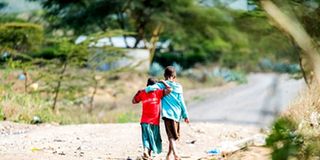Innocence under the razor

What you need to know:
One of the regions with the highest numbers of girls being cut before the age of one, is Singida region. It is the fifth region with the highest prevalence of FGM at 31 per cent.
What happens when you scream and cry out but no one pays attention or understands your pain? This is literary what babies – some younger than one year, and some even younger than a week – face when their genitals are mutilated.
There has been an increasing practice of female genital mutilation (FGM) being performed to under one-year olds, in some communities in the country. 35 per cent of survivors of FGM aged between 15 and 49 years were cut before the age of one. (TDHS-MS; 2015/16)
One of the regions with the highest numbers of girls being cut before the age of one, is Singida region. It is the fifth region with the highest prevalence of FGM at 31 per cent.
In the last episode, we read about Hawa, the ex-cutter and now women’s rights activist, who spoke to Doris – the young influencer and activist – during her journey in the region. She also explained about the cutting of under one year olds, including her own daughter:
“My grandmother was also a midwife, and when expecting mothers were brought to her for delivery, she would also coach me. So eventually I also became a midwife.
I continued assisting my grandmother in performing FGM and midwifery until I was married. My second born was a girl and she was the first one I used a razor blade on, without my grandmother. My daughter was very young then. This is because by the time I got married, cutting girls at an older age had stopped and we no longer had the public “ngomas” {traditional dances) to celebrate the FGM ceremony. The government had started the campaigns to ban FGM.
My grandmother told me I had to cut her when she was a baby because if she grew up and kept her clitoris, she would not get married. I was convinced and I cut her. After that I continued performing FGM on others.
We performed the cutting on babies when they were being delivered, because the government had started campaigning against FGM. We did it [cut my daughter] in secret, to keep it away from my husband and other people. It was only my aunts and grand-mother who knew what was happening.
Before performing FGM on the baby, I prepared my urine and fermented it for seven days in a calabash until it turned bitter. We used the urine to clean the wound from the cut, and smear cow ghee on it in seven days. I also prepared roots from a particular tree. After cleaning the wound, I would prepare a paste by mixing powder from the roots of the tree, ghee and my spit. The paste would be applied on the wound and it healed after a few days. It was painful but that was the treatment.
When the baby cried a lot and my husband would ask what was happening, I would tell him that she was suffering from a stomach disease.
I have seen the challenges of a delivery for a woman who is cut as opposed to a woman who is uncut. For a woman who is cut, first of all she loses a lot of blood compared to a woman who has not undergone FGM.
When the baby pushes through the birth canal and reaches the vaginal opening, it would stretch to accommodate the width of the baby. However, for a woman who is cut, this becomes difficult, and the baby gets stuck for such a long time, it drinks the dirty water [amniotic fluid] which the doctors say is unhealthy for the baby.
Watching my daughter give birth to her first baby was very painful for me. She gave birth in a hospital, and since I am a midwife, the nurses and doctors allowed me to be with her throughout. Her delivery was long and very painful, eventually they had to perform a long surgical cut [episiotomy] to enlarge the baby’s exit. I regretted it a lot, watching the baby struggle and my daughter suffering.
I sometimes meet with the girls I have cut and I feel bad.
For instance, the last girl I had cut, before I stopped being a Ngariba, was my niece – my brother’s daughter. She is now in kindergarten. Back then, if you named a daughter after their grandmother, the grandmother would refuse to be associated with the child unless she was cut. They would say they did not want their names associated with promiscuity.
So when my niece was born, she was not very healthy. Her grandmother urged me to save her granddaughter by cutting her. She really nagged me about it. Eventually I gave in, I performed FGM while she was in critical condition. We continued cleaning her with the urine and potion of mixed ghee. Thank God the baby survived and that was the last time I ever touched a razor to perform FGM.”
Besides the horrific pain and trauma you put a helpless baby through, FGM is also very risky as the baby can lose a lot of blood or contract infections and diseases, or even die.
Throughout the accounts, we have read on how parents and guardians are usually the key decision makers in submitting their daughters to female genital mutilation.
Why would they risk the lives and well-being of their daughters, as well as risk being prosecuted and sent to jail, for a practice that has been condemned for all these years?


